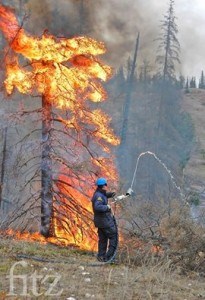
A public information night about the municipality’s emergency plans, May 18, took on an air of greater importance in light of the catastrophic wildfire that forced
more than 80,000 residents in Fort McMurray to flee their homes earlier this month.
Fire Chief Greg Van Tighem spoke to the audience about the various hazards the town could face, such as a wildfire or a train derailment and emphasized over and over again how important it is that individuals are prepared.
“It’s hard to plan for everything so our motto is plan for the worst,” said Van Tighem.
In the event of a full-scale evacuation similar to what happened in Fort McMurray Van Tighem said the most important thing is being prepared.
“I’ll be honest, a full evacuation in Jasper could potentially be very chaotic, very stressful and extremely difficult,” he said. “If you guys are prepared you’re going to make it that much easier for us, the agencies that are responsible for getting you out safely.”
In the event of a full-scale evacuation he said it’s critical that people have a 72-hour emergency kit ready to go, a full tank of gas at all times, listen to emergency messages and try not to panic.
In the event of an emergency there are four main types of evacuations and each one is dependent on the situation.
The first one is an "evacuation with notice," which gives people enough time to prepare to evacuate in case they are ordered to leave.
The second evacuation is a "no-notice evacuation" when something happens unexpectedly such as a chemical spill from a train derailment.
“There are some situations where if that type of thing happens you might not be able to evacuate, that’s when you would be advised shelter in place. That means don’t leave your home, stay inside, close all the doors, turn off your furnace, turn off your air conditioning, close all your windows etc.,” said Van Tighem.
The third type is a "partial evacuation," when–for example–there is a chemical spill that affects only a small portion of the community.
The final and largest evacuation is a widespread or full evacuation order.
“We have three ways in and out. Potentially one or two of those ways could be blocked by the emergency so in a worst-case scenario we only have one way to evacuate,” said Van Tighem, adding there are only three gas stations in town making it impossible for everyone to fill up.
He acknowledged that one of the biggest challenges facing Jasper in the event of a full-scale evacuation in the summer is the number of extra people in town.
“We could potentially have 15,000 extra people in town in July and August, not to mention the people that work here and live here, and we could have a number of people in the back country and we’ve got outlying campgrounds and motels so that number just keeps going higher,” said Van Tighem.
“We are also dealing with people from different countries so there are language barriers and some people may not have vehicles.”
Last year Parks Canada and the municipality got some real life experience during the Excelsior wildfire near Medicine Lake.
During the wildfire Parks Canada evacuated more than 50 people out of the backcountry, and the municipality activated its Emergency Coordination Centre (ECC) to make sure everyone was on the same page incase the fire changed directions and threatened the town.
Following that emergency officials got together for a debrief and played out a bunch of different scenarios. A rough plan was created to address how emergency officials would evacuate Whistlers Campground, Wapiti Campground and various outlying areas.
“I’ll be honest, it’s going to be incredibly difficult,” said Van Tighem, about evacuating those areas.
“But we have the man power and the resources and we have a lot of skilled people.”
In a worst-case scenario he said emergency officials may have to commandeer individual citizens to help evacuate people.
For more information and to familiarize yourself about what to do in an emergency check out the municipality’s website www.jasper-alberta.com.
Paul Clarke [email protected]
What to do in an evacuation
In the event of an evacuation, information from the municipality will be communicated through the Alberta Emergency Alert system.
Information will also be communicated through the Jasper Emergency Information Hotline at 780-852-3311 and on CJAG 92.5 FM.
Other media sources, including the Fitzhugh, the municipality’s website and social media websites will also be used, including Community Outreach Services, Jasper Park Chamber of Commerce, Parks Canada and Tourism Jasper.
During the first 72 hours people should be prepared to look after themselves and their families, as emergency services take care of the community’s most vulnerable populations.
If time allows, ensure you:
- Alert all family members immediately
- Maintain constant knowledge of the whereabouts of all family member
- Have at least a half tank of gas in your vehicle at all time
- Ensure your 72-hour emergency kit and supplies are ready to go
- Secure or prepare to secure your home on departure
- Follow the instructions of local authorities
